The ASUS ZenBook 3 Review: A Convincing Case for Quad Core Thin & Light Laptops
by Brett Howse on November 22, 2017 8:00 AM EST- Posted in
- Laptops
- Asus
- Zenbook
- Core 8th Gen
- Kaby Lake Refresh
GPU Performance
Although the move to 8th Generation Core has brought a nice jump in CPU performance, the same can’t be said for the integrated GPU. Here Intel is using the UHD 620, which other than a minor clockspeed bump, is largely the same as the HD 620 iGPU found on Kaby Lake. At the moment, there are no Iris equipped GPUs either, although that’s not unusual, since they tend to get launched later on. It’ll be curious to see if Intel launches any Iris based Core i7 models based on Kaby Lake Refresh, since they’ve already used up extra die space for more CPU cores.
We’ve already seen Intel announce that they will be building CPUs with AMD's Radeon graphics, but those are going to be targeted at the H series chips, which are the 45-Watt lineup, so on the Ultrabook end of things, the HD 620 is all we’re going to get for now.
The integrated GPUs on Core products have always been a sore spot, since they can generally run desktop workloads just fine, but any additional workloads tend to make them really struggle. Only the lightest games are generally playable at low resolutions, and the only compute available is QuickSync.
Since this is an Ultrabook, we’ve not stressed it like a gaming system, but instead kept to a couple of synthetics, and then one game which can be playable on lower-end hardware.
3DMark
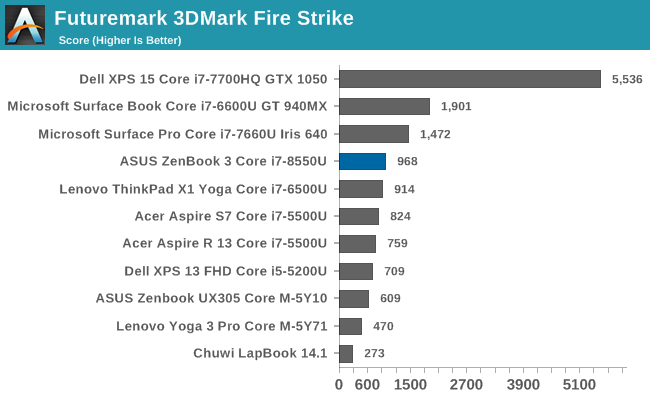
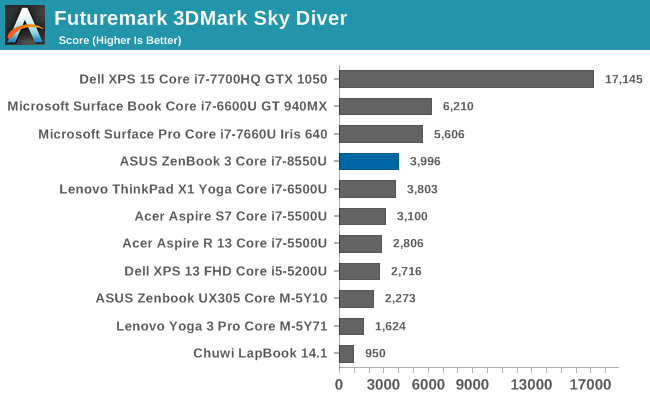
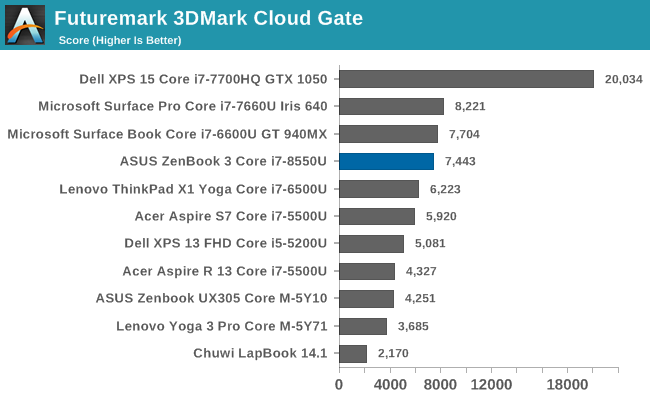


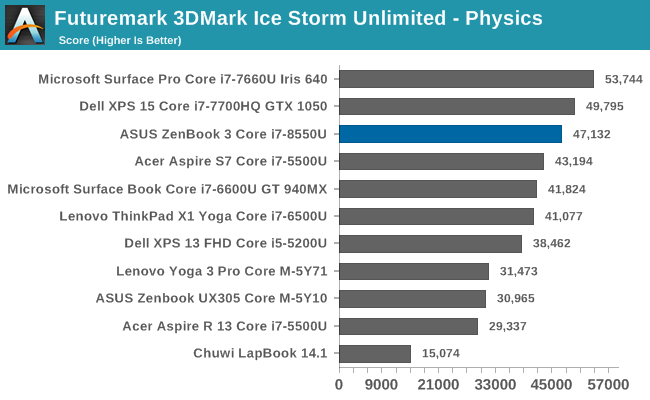
FutureMark has continuously updated it’s 3DMark suite, offering newer tests for even more powerful hardware, but there’s no need to worry about that with integrated graphics. The HD 620 of the ZenBook 3 slots in about where it’s expected, behind the Iris graphics in the Surface Pro, and below the discrete graphics in the Surface Book, which is the GT 940MX on the original, and well below the GTX 1050 on the Dell XPS 15.
GFXBench
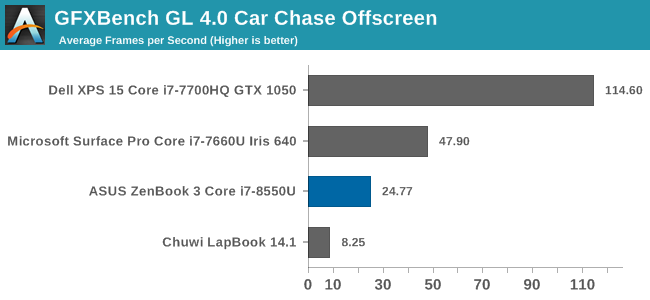
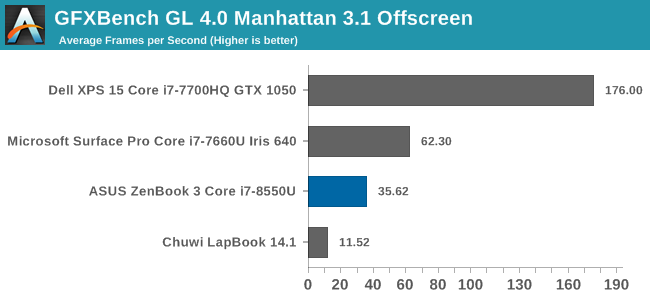
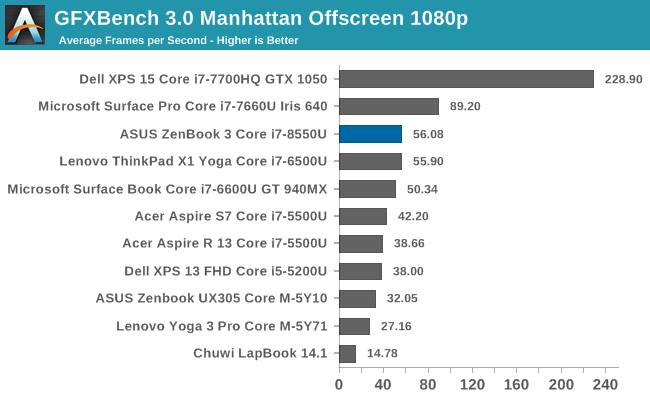
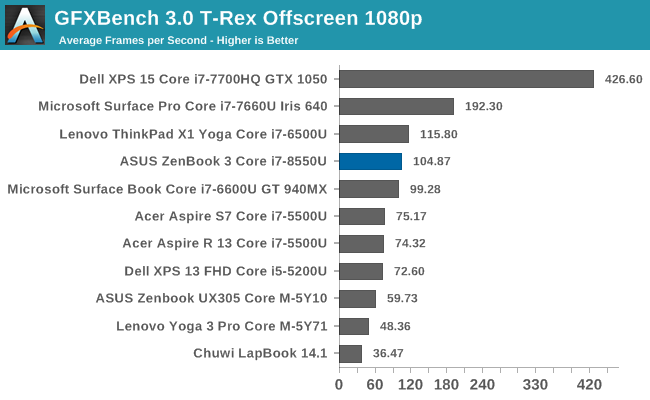
GFXBench is a set of tests that are cross-platform, although the desktop version is OpenGL based and runs at 32-bit precision, rather than the 16-bit precision of mobile devices. Once again, the HD 620 is not very fast, and sits well behind the Iris Plus Graphics 640 in the Surface Pro.
Dota 2 Reborn
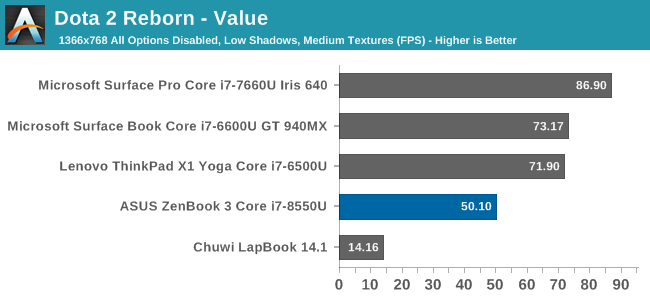

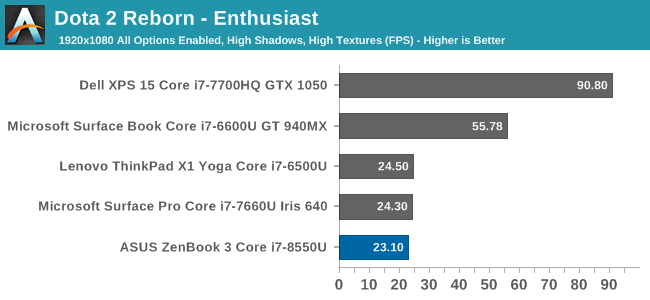
The one game tested is Vavle’s Dota 2, which can run fairly well even on low-end GPUs. The value settings, especially, offer reasonable performance from even integrated graphics. When playing a game, the performance of the ZenBook 3 falls even further behind. Even on the most basic settings, the game can’t quite hit 60 FPS, although all of the integrated GPU systems fall short at our Enthusiast settings.
Storage Performance
ASUS offers two SSD options in the ZenBook 3 UX490UA. The 256 GB is a SATA based SSD, but the larger 512 GB model is a NVMe PCIe 3.0 x4 model. In our review unit is the larger drive, which as it turns out is a Samsung PM961. This is a TLC drive, but thanks to the combination of Samsung’s Polaris controller and their 48-layer V-NAND, performance is very good.
The drive maxes out the PCIe link on reads, and still offers about 1.5 GB/s write speeds under sequential loads. The random read and write speeds are also very solid, assuming you stay in the SLC cache, which for most operations, that shouldn’t be a problem. The PM961 generally outperforms the SM951 MLC drive which was the top option not very long ago.


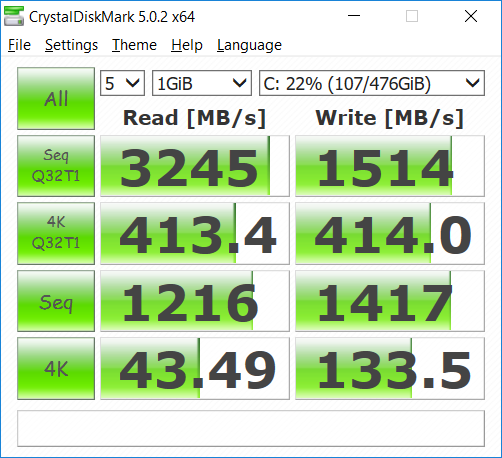








55 Comments
View All Comments
aeronatis - Wednesday, November 22, 2017 - link
I believe they prefer to implement LPDDR to be able to reach long battery runtime during sleep. With standart DDR, any sleeping computer is pretty much out of juice overnight whereas laptops with LPDDR can sleep for days.DanNeely - Wednesday, November 22, 2017 - link
I've been able to sleep Dell Latitudes used by my previous employer over the weekend since the 2008(?) models; AFAIK all of them used standard DDR2/3 not low power sorts.hybrid2d4x4 - Thursday, November 23, 2017 - link
Overnight? That's a pretty major exaggeration. I had a Acer 3830TG (Sandy bridge, 4GB DDR3) that lasted >3 weeks in sleep. And before anyone says it, I always "powercfg -h off" on a new system/OS install.wolrah - Wednesday, November 22, 2017 - link
@labrats5 Who said anything about LPDDR3?@Jimios basically I'm looking for a powerful, portable machine on which to run VMs and do development. It'll never run games or even Windows so an nVidia or AMD GPU is just wasted silicon, wasted power, and annoying driver problems. I'd rather just use the Intel GPU that's built in to the processor and has great Linux support, but basically every proper workstation laptop forces a Quadro on you.
If I want to avoid the GPU I'm stuck looking at the thinner models. I don't really care about thin, I think my 2008-era Macbook Pro (the one right before unibody, that was basically an evolution of the Powerbook G4 design) was perfect as far as size/weight goes.
Jimios - Wednesday, November 22, 2017 - link
Can't the dGPU be completely disabled through BIOS/EFI or something? I haven't owned a non-Apple laptop recently so I honestly don't know.As for your use case (multiple VMs, etc.), I understand, but I don't think there would be too much demand for what you're asking. A laptop with your description wouldn't sell well to justify the development and marketing cost, IMO. Laptops like the article we're commenting on are mass market devices.
Also, typically with "workstation laptops" companies aim at CAD/CAM engineers and creative professionals. Which is sad, and I understand your frustration.
DanNeely - Wednesday, November 22, 2017 - link
As a developer currently using a Yoga with 16GB of ram, while I'd rather have a big laptop with a 45W CPU and 32GB of ram; if I could only have 1 I'd go for the ram multiple VMs or copies o Visual studio and a bunch of loaded browsers max out 16GB more often than I'm CPU limited.wolrah - Wednesday, November 22, 2017 - link
"Can't the dGPU be completely disabled through BIOS/EFI or something? I haven't owned a non-Apple laptop recently so I honestly don't know."I have yet to encounter a dual-GPU laptop where all the video ports were wired through the onboard GPU. Usually at least one of the external ports and sometimes the internal display is wired through the dedicated component, requiring that part to be enabled for those ports to work.
On my current Asus with a GT650M the HDMI port is wired through the nVidia chip so if I want to use an external monitor I have to either use VGA (yuck) or deal with the disaster that is nVidia Optimus. Even under Windows it's annoying, under Linux it's a mess.
linuxgeex - Thursday, November 23, 2017 - link
I've felt the same as you for the last decade, but you'd be surprised these days. AMD GPUs are quite well supported out of the box on open drivers, within 6mo of launch, and generally you can get them up on launch day using recent kernel/Mesa releases. I'll be getting an AMD 2500u based laptop this time around. Probably the Acer Swift.timecop1818 - Thursday, November 23, 2017 - link
> basically I'm looking for a powerful, portable machine on which to run VMs and do development. It'll never run games or even Windows so an nVidia or AMD GPU is just wasted silicon, wasted power, and annoying driver problems. I'd rather just use the Intel GPU that's built in to the processor and has great Linux support, but basically every proper workstation laptop forces a Quadro on you.you had me until "never runs Windows", lol.
nice troll, bro, nice troll.
also, accelerated graphics support in lunix. ha ha ha ha ha.
thanks for the laugh.
IGTrading - Wednesday, November 22, 2017 - link
It will be lovely to watch AMD Ryzen Mobile mop the floor with this 1700 USD waste of money.For this much money, I would expect way better performance, but luckily HP Envy x360z with Ryzen Mobile is just 600 USD.
There's nothing in ASUS' new Zen that's worth the extra 1000 USD they're asking.